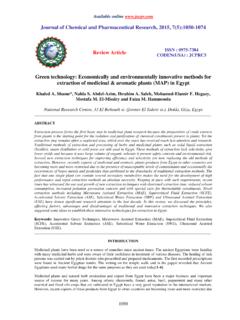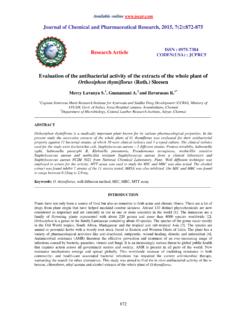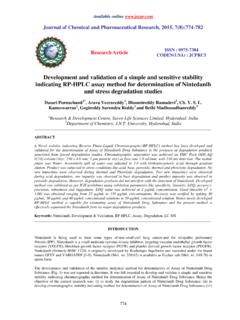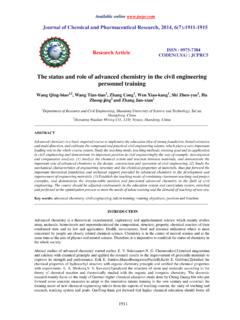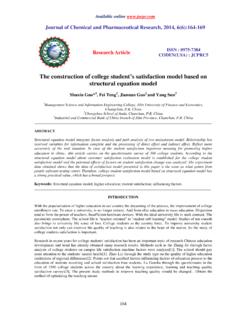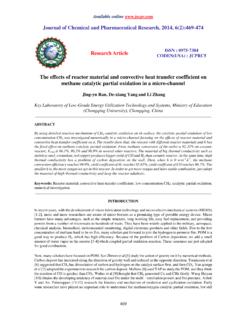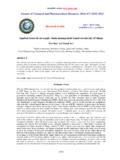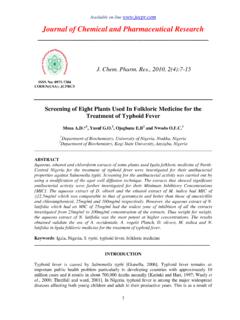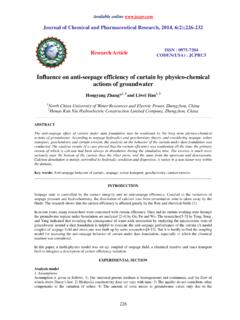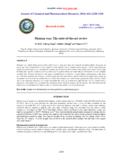Transcription of Journal of Chemical and Pharmaceutical Research, 2016, 8(4 ...
1 Available online Journal of Chemical and Pharmaceutical research , 2016 , 8(4):901-905 review article issn : 0975 - 7384 coden (USA) : JCPRC5 901 Dens invagination: A review of literature and report of two cases Shardha Bai Rathod1*, S. Padmashree2 and Anand V. Nimbale1 1 Department of Dentistry: Shri B. M. Patil Medical College and research Centre 2 Department of Oral Medicine and Radiology Vydehi Dental College Bangalore Vijayapur - 586103, Karnataka, India _____ ABSTRACT Dens invaginatus is a malformation of teeth resulted during development with infolding of dental papilla. The affected teeth radiographically show an in folding of enamel and dentin which may extend in to pulp cavity, root and root apex. Root canal treatment of these teeth is difficult due to complex root anatomy.
2 As such, early identification of a tooth affected by dens invaginatus is important. The aim of the present report is to review the prevalence, aetiology and classification of the anomaly; with two case reports highlight the clinical and radiographic features together with management options. Key words: Dens in dente, invaginated odontome, tooth inclusion, dentoid in dente. _____ INTRODUCTION Dens invaginatus or dens in dente is a developmental malformation of the tooth resulting from infolding of the dental papilla before calcification. The affected teeth radiographically show an infolding of enamel and dentine which may extend deep into the pulp cavity and into the root and sometimes even reach the root apex1. Dens invaginatus in a human tooth was first described by a dentist named Socrates in 1856 (Schulze 1970) 2.
3 Muhlreiter reported on anomalous cavities in human teeth in the year (1873)3. In the year 1887 Tomes reported` The enamel investing the crown may be, and often is, perfectly well-developed; but we shall find at some point a slight depression, in the centre of which is a small dark spot 4. In 1897 Busch first suggested the use of dens in dente which implies the radiographic appearance of a tooth within a tooth. However, Hunter (1951)5 suggested the term dilated composite odontome which infers an abnormal dilatation of the dental papilla whilst Colby (1956)6 recommended the use of gestant anomaly . Dens invaginatus is common clinical finding in permanent teeth and probably occurs more often than other developmental anomalies.
4 For example, Backman & Wahlin (2001)7 examined a group of 739 individuals and reported that of subjects had evidence of dens invaginatus. Prevalence of dens invaginatus: The prevalence of maxillary lateral incisors and bilateral occurrence is not uncommon and occurs in 43% of all cases (Granhnen et )8. Conklin 1968 presented a patient with all maxillary central and lateral incisors affected 9. The permanent maxillary lateral incisor appears to be the most frequently affected tooth (Hulsmann 1997)1 with posterior teeth less likely to be affected (Conklin 1978, Lee et )10-11. Of the affected teeth, 90% were lateral incisors and only were posterior teeth; interestingly, no mandibular teeth were reported to be affected by dens invaginatus. Krolls (1969)12 detected dental invaginations in maxillary central incisors as well as in several maxillary and mandibular bicuspids in one patient.
5 Conklin (1978)10 found the anomaly in four mandibular incisors in one patient. There have also been case reports of dens invaginatus occurring in the primary dentition (Rabinowitch 1952, Holan 1998, Kupietzky 2000, Eden et al. 2002) . Interestingly, Mann et al. (1990) 13 in a study of skeletons identified the anomaly in the deciduous second molar of a 5-year-old fourteenth-century. Shardha Bai Rathod et al J. Chem. Pharm. Res., 2016 , 8(4):901-905 _____ 902 Aetiology of dens invaginatus : The aetiology of dens invaginatus malformation is controversial and remains unclear. Over the last decades several theories have been proposed to explain the aetiology of dental invaginations: Kronfeld (1934)14 considered that the problem was the result of the retardation of a focal group of cells, with those surrounding continuing to proliferate normally and engulfs the static area.
6 Rushton (1937)15 proposed that the invagination is a result of rapid and aggressive proliferation of a part of the internal enamel epithelium invading the dental papilla. Atkinson (1943)16 suggested that the problem was the result of external forces exerting an effect on the tooth germ during development. Such forces could be from adjacent tooth germs results in buckling of the enamel organ. Whilst other external factors such as trauma (Gustafson and Sundberg 1950)17 and infection (Fischer 1936, Sprawson 1937)18-19 have also been suggested as a cause. During the development of teeth ectomesenchymal signalling systems that occur between the dental papilla and the internal enamel epithelium affect tooth morphogenesis (Ohazama et al. 2004)20. The absence of certain molecules for the normal growth can result in abnormally shaped teeth as well as defects in the developing tooth germ (Dassule et al.)
7 2000)21. For the above reason the proposal that genetic factors may be the cause of dens invaginatus has some credibility (Grahnen et al. 1959). Oehlers (1957) 22-23 considered that distortion of the enamel organ during tooth development and subsequent protrusion of a part of the enamel organ will lead to the formation of an enamel-lined channel ending at the cingulum or occasionally at the incisal tip. The latter might be associated with irregular crown form. Classification of dens invaginatus: The first attempt to classify dens invaginatus was by Hallet (1953)24 suggested the existence of four types of invagination based on both clinical and radiographic criteria. Schulze & Brand (1972)25 suggested an assessment based on twelve possible variations in clinical and radiographic appearance of the invagination.
8 However, the most commonly used classification described by Oehlers (1957)22 because of its simple nomenclature and ease of application. This system categorizes invaginations into three classes as determined by how far they extend radiographically from the crown into the root (figure1). Type I (A): An enamel-lined minor form occurring within the confines of the crown not extending beyond the amelocemental junction. Type II (B&C): An enamel-lined form which invades the root but remains confined as a blind sac. It may or may not communicate with the dental pulp. Type III (D): a form which penetrates through the root perforating at the apical area showing a second foramen in the apical or in the periodontal area. There is no immediate communication with the pulp. The invagination may be completely lined by enamel, but frequently cementum will be found lining the invagination.
9 Figure showing Dens invaginatus: Type I (A) Dens invaginatus: Type II(B) Dens invaginatus: Type II(C) Dens invaginatus: Type III (D) Shardha Bai Rathod et al J. Chem. Pharm. Res., 2016 , 8(4):901-905 _____ 903 CASE REPORT: 1 A 12-year old male patient was referred to the department of dentistry in VID &RC for dental treatment of the maxillary left lateral incisor. On examination patient could not give a definite history of trauma, but complaints of swelling and pus discharge intermittently in relation to maxillary left lateral incisor since one month. A slight tender swelling was noted on palpation in the vestibule of the apex of the tooth with 21, 22 and sinus opening present. Vitality Testing= 21, 22(No response on thermal testing). A periapical radiograph revealed a diffuse apical radiolucency with abnormal crown and root canal morphology.
10 The radiopaque infolding of enamel in the coronal aspect with a opening in the incisal edge extending in the pulp chamber & radicular canal with an open apex surrounded by well defined radiolucency extended periapically involving 21, 22. Diagnosis was made as Dens Invaginatus type II with 22, with necrotic pulp and a periapical abscess. Hence endodontic treatment was recommended with 21, 22. A 25 year old male patient reported to department of dental in VID & RC with the chief complaint of discolouration of the tooth of the maxillary right central incisor. No previous history of trauma. History of pain and swelling had been present intermittently for last 3 months. On examination morphologically tooth was large in size, discoloured, rotated and extruded.
